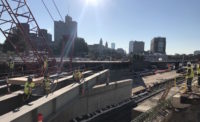Crews demolishing a school adjacent to Fenway Park plan to have the building down by the end of March, just before the Red Sox April 9 home opener. Demolition of the existing Boston Arts Academy began on Dec. 31 to prepare for construction of a new $125 million school.
“We’re working closely with the Red Sox and management teams for apartment buildings in the area to make sure they are aware of activity in coming months,” says Brian McLaughlin, chief of staff for the City of Boston Public Facilities Department.
The Fenway project is Boston Public School’s first new school building project included in the $1 billion Phase II BuildBPS, according to school department officials. Officials say the 10-year educational and facilities master plan is the district’s first long-term strategic facilities plan in more than 40 years.
The project, which broke ground on Oct. 31, will increase the size of the school from 121,000-sq-ft to 153,000-sq-ft. The five-story building, designed by Perkins Eastman with Wilson Butler Architects, is expected to be complete in 2021. It will include a new 500-seat theater with a proscenium stage, a black box theatre, dance studios, a recital hall, art gallery, music practice rooms and other enhanced functional space.
Managing construction in a tight neighborhood setting is the greatest challenge for the Boston Arts Academy as well as for other future BPS construction projects, McLaughlin says.
Joe Berry, project executive for general contractor Lee Kennedy Co., says such constraints “make planning, managing expectations and communicating that much more important for all trying to work together harmoniously.” With no site or staging area “we’re relying on cooperation with the city and neighborhood agencies to work on our construction means and methods.”
Berry says demolition of some underground elements such as a partial basement and foundation elements “will follow from late spring into summer.”
BPS Interim Superintendent Laura Perille on Nov. 28 released a report on the proposed second phase BuildBPS, which she says will include approximately a dozen construction and renovation projects expected by 2027.
The second phase plan builds on the first comprehensive BuildBPS plan released in March 2017, which aims to expand equitable access to quality schools and programs, while reducing the number of times students transition into different schools.
School officials have said two thirds of Boston’s 125 schools were built before World War II with many overdue for renovation or replacement, including the Boston Arts Academy, the Eliot (grades K-8), the Carter School, and the Quincy Upper School, either in or pending construction.
BPS outlined key aspects of its plan in a presentation to the Boston School Committee in October, and has held numerous community meetings across the city since then. Additional meetings are ongoing and will continue throughout the year.
“In the systemic BuildBPS 10-year plan, a fundamental principle is to transform the BPS facilities landscape in a way that fosters the conditions for 21st century learning,” says Dan O’Brian, a BPS spokesman.
“The district aims to focus on improving facilities and programming to meet student needs, including kitchen projects, schoolyard improvement, technology infrastructure, security upgrades, modern school furniture, and climate control and energy efficiency, among other investments.”
In the North End, the Eliot school, a three-building school broke ground for its 585 Commercial St. building in June. When completed by Sept. 2019, it will include an art studio, robotics-engineering lab and collaborative learning spaces, according to the school’s website.
On the border of Lower Roxbury and the South End, the Carter School for students with severe cognitive, physical or medical challenges, is scheduled to start design in late winter or early spring, McLaughlin says. The Massachusetts School Board Authority (MSBA) is currently finalizing the prerequisite requirements for the school and hopes to start design in late winter or early spring, he says.
BPS is still trying to find a site for Quincy Upper School. Since backing away from plans to build a new Quincy Upper School at 90 Warren Ave. in the South End, the site of the McKinley School, city school officials have been exploring various sites, “but nothing is definitive,” McLaughlin says. He added that his team is working closely with the MSBA, which will reimburse up to 60% of eligible cost for design and construction.
The Boston School Committee on Dec. 19 voted 5-0 to close the Urban Science Academy and West Roxbury Academy comprising the West Roxbury Educational Complex in West Roxbury over the next two years, according to a Boston Globe report.
BPS has expressed interest in building a new secondary school (grades 7-12) at the current location of the complex, but no plan has been formalized yet.
O’Brien, the BPS spokesman, says the complex would be closed based on physical condition. Rather than continuing to defer maintenance, “we want to take a strategic approach,” he says. He added that the McCormack Middle School on Columbia Point in Dorchester was also planned for closing.
In East Boston, BPS is looking at building schools in the Dorchester/Mattapan border area because there are not enough seats for current student enrollment, but no formal plan exists yet, O’Brien added.
The master plan also calls for eliminating six of the system’s remaining middle schools and reconfiguring them into elementary or secondary schools. This is due to dramatic declining enrollment, O’Brien says.
McLaughlin says collaboration between the city’s public facilities department and the MSBA is beneficial. By taking advantage of the MSBA Accelerated Repair Program for roofs, windows and boiler upgrades, the department in collaboration with the MSBA on more than 20 repair projects, has seen $30 million in reimbursements on $50 million plus in total school repair costs on structurally sound buildings.
The goal of BuildingBPS now and into the future is to maximize the money put into city schools while getting reimbursed from the state to get the most out of the money invested, McLaughlin says. “We’re looking to extend the useful life of a valuable asset … able to deliver the educational program of a school but for the fact that it may need a system upgrade.”








Post a comment to this article
Report Abusive Comment